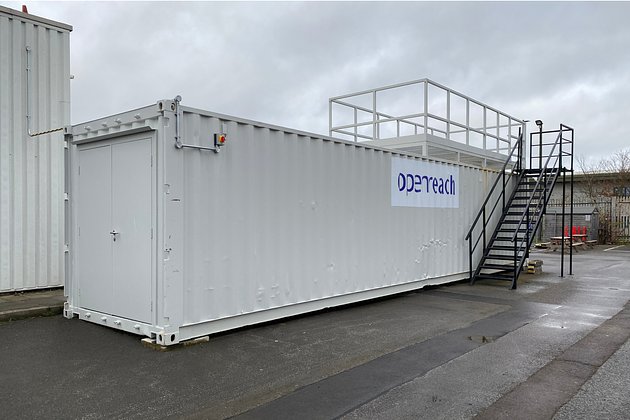10 Things That Your Family Taught You About Confined Space Containers
페이지 정보
작성자 Jodi Croft 날짜25-02-19 09:46 조회0회 댓글0건본문
 Using Confined Space Offshore Containers (page) to Prevent Hazards
Using Confined Space Offshore Containers (page) to Prevent HazardsConfined spaces are unique environments that can pose numerous dangers. These can include oxygen deficiency and toxic atmospheres, explosive atmospheres, and physical hazards.
 These restricted areas can also cause accessibility, communication, and rescue problems. The best thing to do is avoid entering these areas unless it is absolutely necessary.
These restricted areas can also cause accessibility, communication, and rescue problems. The best thing to do is avoid entering these areas unless it is absolutely necessary.Training
If employees work in restricted spaces, it's crucial that they're trained to be aware of the dangers that exist in these areas and to take precautions accordingly. This training can prevent accidents and 30ft Shipping container ensure workers are ready to respond in the event of an emergency. The training covers subjects like entry procedures and permits warning signs as well as personal obligations as well as air monitoring equipment and the potential dangers.
In addition to being trained on the particular dangers of working in confined areas, workers should also be taught basic emergency procedures that could be performed in an emergency in a confined space. This includes locking and marking connected piping and assessing the quality of air for breathing, forcing ventilation, as well as making sure emergency personnel are on hand.
While this is an excellent idea for any employee who may be required to work in tight spaces, it's especially necessary for those who frequently access these areas. This includes attendants and entrants as and supervisors. This type of training is also beneficial to representatives of controlling companies, host employers, safety managers, and other employees at construction sites with restricted areas, as they will be accountable for implementing proper entry procedures.
The course focuses on a range of different hazards, including lack of oxygen, toxic gasses, and fires. It teaches you how to use special equipment like self-rescue equipment and emphasizes the importance keeping a clear mind during emergency situations. It also covers important procedures, such as confirming the area is safe for entry and keeping in contact with an outside party during an emergency in confined areas.
Besides the training mentioned above There is also a tool that can complement the theoretical instruction to include a realistic and experiential element: virtual reality. This technology provides trainees with the opportunity to experience the procedure of entering a restricted space by wearing VR glasses. The trainer configures the simulation, however the user is able to make decisions in the scenario to enter a real restricted space without risking their life.
A mobile container is a safe and effective way to simulate the conditions that could exist in confined spaces. The mobile container is used in a wide range of industries, including mining and the energy sector. It's also utilized by firefighters, law enforcement and other emergency response teams to build skills for hazardous situations.
Ventilation
Ventilation is the process of moving air to remove harmful pollutants from a space. It can be achieved in a variety of ways, but the objective is always to maintain oxygen levels at an acceptable level and keep levels of contaminants below their LEL (above their upper limit of explosion). It's also important that the air flowing through the space is clean, meaning it has not been exposed to harmful chemicals or hydrocarbon gases which could create an explosive atmosphere.
The most significant risk in confined spaces is the build-up of toxic gases and/or oxygen depletion. The confined spaces could be hazardous because of other dangers such as chemical and biological exposure, fire dangers infiltration, and mechanical and physical hazards. Before doing any work in a closed space, a risk assessment must be completed. This will reveal any potential dangers and determine the appropriate control measures needed like ventilation.
When conducting the risk assessment, it is essential that a thorough inspection of the area is conducted to ensure it has the required requirements for entry. This inspection will include checking the entry and exit points, as well as determining whether there are liquids or free-flowing solids that could entangle or suffocate an individual, and identifying the potential for fire hazards, chemical and biological exposure, engulfment, contaminant levels and other factors.
After the risk assessment, the Confined Space Entry Permit is required. A plan for the work should be formulated. The plan should outline the equipment required as well as the ventilation method for the confined area.
If the space is an old 30ft Shipping Containers container that was used as an outdoor storage area the shipping container sizes uk, it will need to be modified to allow for adequate airflow.
This will require making an opening for entrance into the confined space as well as ducting to eliminate any contaminants present. The ducting needs to be designed to provide the appropriate amount of airflow, taking into account the size of the space, the type and volume of contaminants, as well as their exposure limits. A ventilation fan should be selected that can provide at least 20 air changes/hour to be effective.
Atmosphere
Gases, vapors, and fumes in enclosed spaces can be dangerous without adequate ventilation. In addition, household cleaning products can produce toxic fumes when in the tight spaces.
Methane can naturally accumulate in small spaces due to the decomposition organic material. Manure pits, sewers silos and storage tanks underground that used to store rotting grains can all produce this toxic gas. Carbon monoxide can also be produced by burning equipment.
A hazardous atmosphere is caused by flammable gases or liquids and dust that can ignite suspended in the air or an atmosphere with low oxygen levels. Such atmospheres present a risk of explosion or fire, and can cause the death of workers immediately. Entrants are also killed by liquids or solids that flow freely. The danger is exacerbated when an entrant becomes engulfed by the flow of material and is unable to escape.
Workers entering confined spaces have to wear portable direct-reading monitors to check for oxygen and harmful gases. It is crucial to understand that a contaminant only creates an unsafe atmosphere if its concentration exceeds the TLVs for acute health effects, or if it will affect a worker's capacity to escape from the space without assistance.
If the oxygen level falls below 19.5 percent, a dangerous atmosphere can quickly become fatal. This lower level is known as an oxygen deficient atmosphere. In contrast to oxygen, contaminants like hydrogen sulfide or carbon monoxide do not appear and are therefore difficult for people to recognize them.
The reading of the instrument should be checked at least once every five minutes to ensure that it is working properly. A wire could break, a sensor may move around, or a trim pot can change, all of which can alter the reading. Electrical instruments must also be checked for continuity and voltage. Workers should also wear proper PPE, including respirators and safety harnesses or lines for support in the event they have to escape from a hazardous situation. A plan for emergency rescue is required and employees should be within sight of a trained professional.
Access
Whether it's an attic or Hu.Feng.Ku.Angn.I.Ub.I...U.K37@Hu.Feng.Ku.Angn.I.Ub.I...U.K37@raid-legends.ru crawl space, or a small storage space the workers who are entering these areas must follow specific safety standards and communicate with a designated attendant. These confined spaces can present serious dangers to those who aren't adequately prepared.
Inexperience, lack of training and ignoring permit conditions are the main reasons for accidents in confined spaces. The last one is particularly important because three out of five victims of accidents in confined spaces are the rescuers themselves. This is because it is simple for dangers to get into the confined space, or for the atmosphere to can quickly become dangerous due to a lack of oxygen, hazardous materials, or other environmental problems.
A confined space is a place that meets any of four criteria: it's enclosed that is difficult to get into and has a risk that could cause death within less than 10 minutes. In an emergency, it could be difficult for others to get in the area. These include small grow rooms commercial freezers, keg coolers tunnels and sewers silos, water tanks and access shafts.
The workplace will require special equipment for people who work in these areas regularly. These tools and technologies can help to make the work easier and safer while reducing the risk of injuries and Offshore Containers (https://www6.aitsafe.Com/) deaths. The camera-on-a-stick is one good example. It allows workers to lower the camera into a confined area to get images underneath and around objects, without having to enter that space.
Portable gas monitors are another essential piece of equipment for confined spaces. This device is able to detect dangerous levels of gases in the air that could pose a threat to the safety of those working in the. It can also be used to find potential sources of danger, like leaky pipework or an alarmingly lower oxygen level.
There are also other technologies and tools that can be used to improve the efficiency and effectiveness of inspection and repair tasks in areas with limited space. For instance, a small robot that can be guided around the space to gather information is a great choice for those who have to perform complicated maintenance in tight spaces. Holographic displays are also an excellent method of displaying where hazards are and how to avoid them.
댓글목록
등록된 댓글이 없습니다.



















 광송무역
광송무역
 070-7762-8494
070-7762-8494

